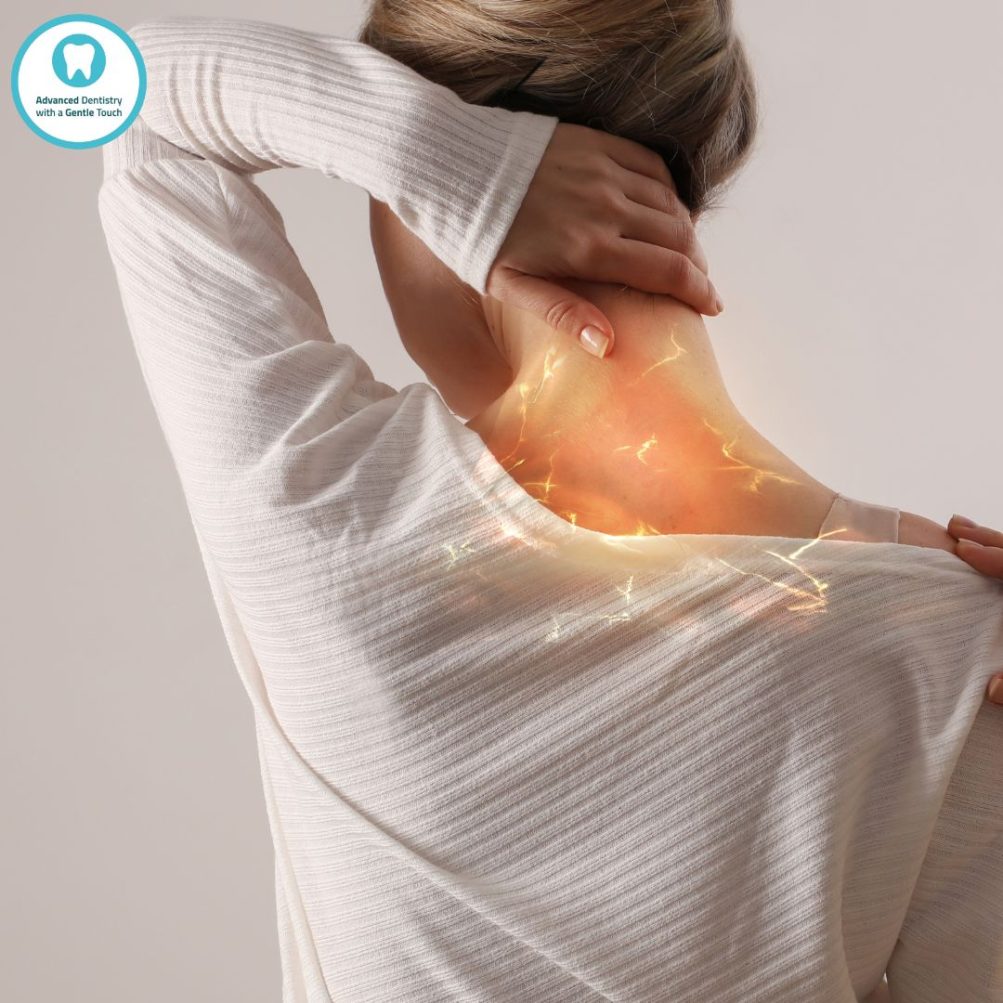The Connection Between TMJ and Neck Pain

The temporomandibular joint (TMJ) is a small but essential part of the body that connects the jawbone to the skull. It plays a crucial role in daily activities like chewing, speaking, and yawning. Without it, simple tasks such as opening and closing the mouth would be difficult. Located on both sides of the head, just in front of the ears, the TMJ ensures smooth jaw movement and alignment.
TMJ disorders (TMD) are common and affect millions of people worldwide. These disorders can cause symptoms of TMJ, such as jaw pain, headaches, and clicking sounds when moving the jaw. Some may also experience neck pain, muscle tension, or discomfort that spreads to the shoulders. TMD can develop from stress, teeth grinding, injury, or arthritis, often leading to long-term discomfort if left untreated. That is when seeking professional TMJ treatment becomes necessary.
This article aims to explore the connection between TMJ and neck pain. We will look at how TMJ dysfunction affects the neck and jaw muscles, highlighting symptoms like pain in the neck and jaw left side. Additionally, we will provide insights into practical ways to manage and relieve neck pain from TMJ. Understanding this link can help improve quality of life and promote better health.

Understanding the TMJ and Its Role in the Body
Anatomy of the TMJ
The temporomandibular joint (TMJ) is a complex structure that allows the jaw to move smoothly. It connects the lower jawbone (mandible) to the skull, right in front of each ear. This joint is made up of bones, muscles, ligaments, and a disc that cushions the movement between them. The disc ensures the bones don’t rub against each other, preventing wear and tear during activities like chewing or speaking.
Muscles around the TMJ control jaw movement, allowing it to move up and down, side to side, and forward and backward. Ligaments help keep the joint stable while nerves send signals between the brain and jaw, controlling movement and sensation. Proper coordination between these components ensures smooth and pain-free jaw function.
TMJ and Its Connection to the Neck
The TMJ and cervical spine (neck) share a close anatomical and functional connection. When the TMJ isn’t working properly, it can place stress on nearby muscles, leading to neck pain and stiffness. The muscles that control the jaw also extend into the neck and shoulders, meaning any imbalance in the TMJ can affect these areas.
Referred pain is common with TMJ disorders. This occurs when discomfort from the jaw spreads to nearby regions, causing pain in the neck and jaw on the left side or even both shoulders. Understanding this connection can help identify the root cause of neck and shoulder pain and guide appropriate treatment.
See also Flossing...it’s Not Just for Gums Anymore!

How TMJ Disorders Cause Neck Pain
Muscle Tension and Strain
TMJ disorders often lead to muscle tension and overuse in the neck. The muscles surrounding the TMJ, including the sternocleidomastoid and trapezius, can become strained due to clenching, grinding (bruxism), or misalignment of the jaw.
These habits force the neck muscles to overcompensate, causing stiffness and discomfort. Misalignment of the TMJ creates an imbalance, which directly affects the cervical spine and nearby muscles, leading to persistent tension and pain.
Nerve Irritation and Referred Pain
Irritated nerves near the TMJ can trigger pain in the neck and shoulders through referred pain. The trigeminal nerve, which plays a key role in jaw sensation and movement, is closely connected to the TMJ. When this nerve is irritated due to TMJ dysfunction, it sends pain signals to other regions, including the neck and jaw on one side.
These signals can also reach the shoulders, creating widespread discomfort. This mechanism explains why TMJ disorders often present symptoms like neck and shoulder pain or discomfort radiating to the upper back.
Postural Implications
Poor posture contributes to and results from TMJ dysfunction, exacerbating neck pain. Forward head posture, often seen in individuals with TMJ issues, places additional strain on the neck and jaw muscles. This position forces the cervical spine out of alignment, increasing muscle tension and discomfort.
Over time, the combination of poor posture and TMJ dysfunction creates a cycle of pain that can significantly impact daily activities. Addressing posture is crucial for managing and preventing TMJ-related neck pain.

Recognizing the Symptoms of TMJ-Related Neck Pain
Key Indicators of TMJ Issues
TMJ disorders can present a variety of symptoms that often overlap with neck pain. Common signs include jaw clicking or popping sounds when opening or closing the mouth. Some individuals may also experience jaw locking, making it difficult to open or close their mouths fully.
Facial pain is another frequent symptom, often centered around the TMJ. Difficulty chewing or discomfort while eating can also indicate TMJ dysfunction, as the joint struggles to perform smooth, pain-free movements.
Signs of Neck Pain Linked to TMJ
Neck pain associated with TMJ disorders often comes with specific symptoms. Stiffness in the neck and shoulders is a common complaint caused by the overuse or strain of muscles connected to the TMJ. Radiating pain from the jaw to the neck is another indicator, as the muscles and nerves surrounding the TMJ extend into the cervical spine.
Many individuals also report headaches that originate at the base of the skull, often triggered by tension in the neck and jaw muscles. Recognizing these symptoms early is essential for effective treatment. TMJ-related neck pain can significantly impact daily life, but understanding its key signs can help individuals seek timely care and improve their overall quality of life.
See also Maintaining Dental Health When Hormones Change with Contraception

Diagnosing TMJ-Related Neck Pain
Clinical Assessment
Diagnosing TMJ-related neck pain starts with a thorough clinical evaluation. Dentists or healthcare providers often begin by palpating the jaw and neck muscles to check for tenderness, stiffness, or swelling. This hands-on approach helps identify muscle tension and areas of discomfort. Observing jaw movement is another key step.
Providers will ask patients to open and close their mouths while monitoring for clicking, popping, or limited movement. Posture is also assessed, as poor alignment of the head and neck can worsen TMJ symptoms.
Diagnostic Imaging and Tests
Dentists may recommend diagnostic imaging to get a clearer view of the underlying issue. MRIs are commonly used to assess soft tissues around the TMJ, helping to detect disc displacement or inflammation. CT scans provide detailed images of the bones, revealing structural problems in the jaw or cervical spine. X-rays can highlight joint abnormalities or arthritis affecting the TMJ.
These imaging tools help differentiate TMJ disorders from other potential causes of neck pain, ensuring accurate diagnosis and targeted treatment. By combining clinical assessment with imaging, providers can develop a comprehensive plan to effectively address TMJ-related neck pain.
Treating TMJ-Related Neck Pain
Non-Surgical Treatments
Most cases of TMJ-related neck pain can be treated without surgery. One of the best ways to relieve tension is through physical therapy. A physical therapist can guide you through exercises that loosen tight jaw and neck muscles. These exercises can improve posture and reduce strain on the temporomandibular joint (TMJ).
Managing stress is also important. Simple relaxation techniques like deep breathing or meditation can help stop clenching and grinding, which are common symptoms of TMJ. Wearing an oral appliance, such as a night guard, can prevent teeth grinding while you sleep. This reduces pressure on the TMJ, easing pain in both the jaw and neck.
Medications and Pain Management
Medications can help reduce TMJ symptoms and ease neck pain. Over-the-counter pain relievers like ibuprofen work well to reduce inflammation and discomfort. For more severe pain, doctors may recommend muscle relaxants to calm tight jaw and neck muscles. Anti-inflammatory drugs can also relieve swelling in the joint.
Applying heat or ice is a simple way to manage pain at home. Heat relaxes the muscles, while ice reduces swelling. Some people find relief with topical treatments, such as pain relief gels, applied to the jaw and neck.
Alternative Therapies
Alternative therapies can help relieve pain in addition to standard treatments. Acupuncture is one option that targets muscle tension. Chiropractic care can improve posture, which helps with neck and jaw alignment.
See also Dental Health Tips: Mouthwash Can Hinder the Benefits of Exercise
Massage therapy is another effective way to loosen muscles in the neck and shoulders. This can relieve TMJ neck pain symptoms that often spread to nearby areas. It’s important to choose treatments that are safe and recommended by a healthcare provider.
Surgical Options (If Necessary)
Surgery is rarely needed for TMJ disorders but may be an option for severe cases. If the joint is badly damaged, a dentist or TMJ expert may recommend surgery to repair or replace the joint. This is usually a last resort when other treatments don’t work.

Preventing TMJ and Neck Pain
Lifestyle and Posture Improvements
Maintaining good posture is essential to prevent TMJ disorders and neck pain. When working at a desk or using a phone, keep your head aligned with your shoulders to avoid straining your jaw and neck muscles. Avoid slouching, as poor posture can put extra pressure on the temporomandibular joint (TMJ) and lead to discomfort.
To prevent jaw overuse, limit foods that are hard to chew, such as gum or tough meats. Eating softer foods and cutting large bites into smaller pieces can reduce stress on the jaw joint. Be mindful of habits like nail biting or chewing on pens, as they can aggravate TMJ symptoms over time.
Stress Management and Daily Habits
Managing stress is key to preventing TMJ-related neck pain. High stress levels can lead to clenching or grinding, which puts strain on the TMJ. Simple relaxation techniques, such as mindfulness or meditation, can help relax the jaw and reduce muscle tension.
Incorporate gentle jaw and neck stretches into your daily routine to keep muscles flexible and reduce stiffness. Practicing these stretches regularly can help improve posture and prevent neck and jaw pain. Small changes to daily habits can make a big difference in protecting the TMJ and avoiding unnecessary discomfort.
Conclusion
TMJ disorders and neck pain are closely connected, with symptoms often overlapping. Muscle tension, nerve irritation, and poor posture can all contribute to discomfort in the jaw, neck, and shoulders. Recognizing the symptoms of TMJ, such as jaw clicking, facial pain, or stiffness in the neck, is essential for early intervention. Simple treatments like physical therapy, stress management, and oral appliances can help relieve neck pain and improve jaw function.
If you experience persistent jaw or neck pain, it’s important to seek professional help. Consulting Dr. Korwin, a TMJ expert in Red Bank and an experienced dentist in Middletown, NJ, can lead to a proper diagnosis and personalized treatment plan. Addressing TMJ-related neck pain early can prevent further complications and improve overall quality of life.
Don’t wait for symptoms to worsen – take the first step toward relief today.
